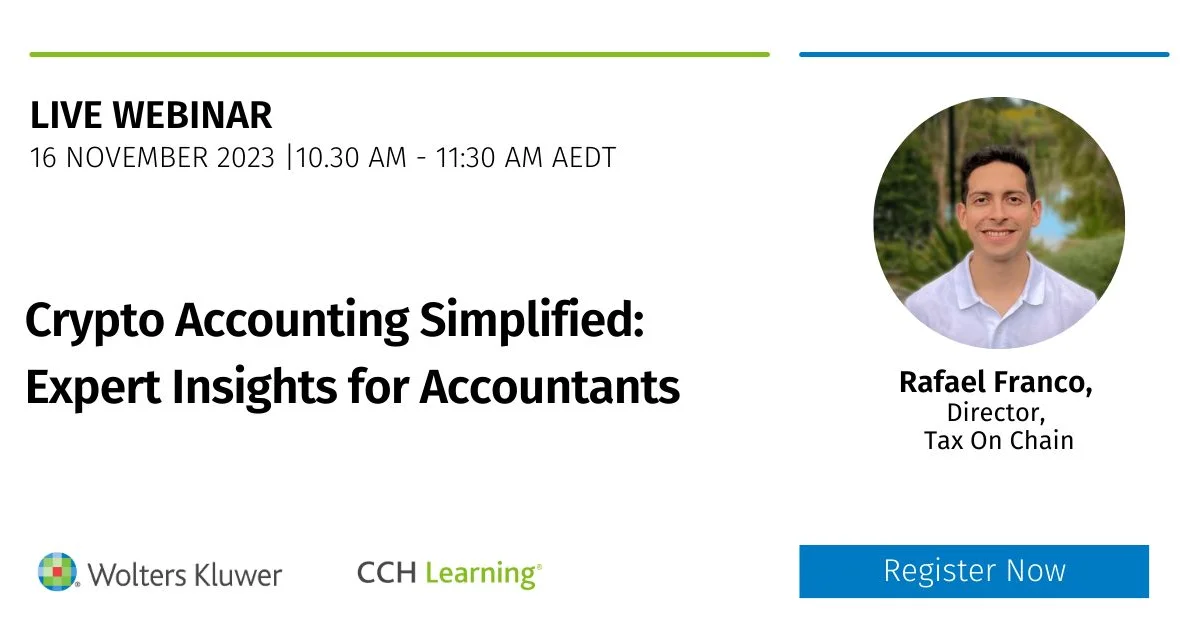Not everyone should take control of their superannuation. This article covers at a high level what people should consider before making the leap into SMSFs.
Disclaimers – this article:
- Is not tax advice, financial advice, legal advice or security advice;
- Is intended for Australian readers but may be relevant to others;
- Focuses on Ethereum but may be relevant to other Ethereum Virtual Machine (EVM) compatible or equivalent blockchains;
- Is not sponsored.
This article is the first in a series of two core articles that will attempt to give a more weighted and informed argument as to why SMSF trustees should consider crypto as part of a broader strategy to provide for their retirement. It is written by a crypto accountant who joined and has been an active participant in the crypto space since 2017.
Sole Purpose
The hallmark of every SMSF is defined in section 62 (1) of the Superannuation Industry (Supervision) Act 1993 (“SIS Act”), otherwise known as the Sole Purpose Test. The sole purpose of any superannuation fund is to provide benefits to the members of the fund upon their retirement.
It is important to ensure that any investment in crypto (or any other asset class) aligns with this purpose and will not compromise the fund’s ability to meet its objectives.
Diversification
At the time of writing, the laws that regulate holders of an Australian Financial Services Licence (AFSL) do not allow for licencees to provide financial advice to their customers in relation to cryptocurrency assets. As a result, it is not possible to have exposure to the crypto market through most public funds. As such, individuals may look to self-manage a portion of their superannuation to achieve this.
It is also worth keeping in mind that diversification can be considered at an overall net worth level, not just your investments inside of the superannuation system. For example, if your largest asset is your family home or your business and you don’t have sufficient funds outside of super to invest elsewhere, investing a portion of your super in crypto may help to achieve a greater level of overall diversification.
Time Horizon
Individuals that wish to hold crypto assets in their superannuation should be aware of their time to retirement and, by extension, the time they have in the market to ride out bull and bear market phases.
Those that are younger may be able to afford to take more risks as they have more time to recover from any financial losses. Conversely, those that are older may not be in a position to afford a financial hit to their nest egg or have enough time to fully recover from any potential losses.
That being said, individuals should still position themselves in crypto assets that are more likely to stand the test of time, or be disciplined to set strict time horizons for the ownership period of those that don’t possess that trait.
Size
The size of your investment into crypto should be considered both at a dollar value and at a percentage of your net worth, both in superannuation and overall.
Size very closely intertwines with many other determining factors, the first of which relates to expected costs in maintaining a fund. Put simply, as costs increase, so too does the need for a higher starting balance or higher return on investments to balance this out.
The other key factor when considering the size of a fund’s crypto investment is the Risk tolerance of members. In short, the higher the risk tolerance, the higher the investment can be into crypto. Both factors are considered in more detail below.
Risk Tolerance
To paraphrase Ryan Sean Adams of Bankless, crypto is the frontier and it’s not for everyone. Crypto has a proven track record of significantly high levels of volatility and can retrace as much as 99% of it’s all-time high prices. In addition to price risks, there are a broad range of risks that are native to the crypto space to consider, including but not limited to smart contract risk, counter party risk and security risks.
Individuals should be aware of what their own risk tolerance is and where it maps in comparison to crypto on a typical risk/return chart. If you don’t know what you risk tolerance level is, or you aren’t sure, you can find a survey online to find out or seek advice from a financial advisor that can guide you through the process.
Individuals that have higher risk tolerance will be the ones that are better positioned for investing their superannuation into crypto.
It’s also worth keeping in mind that risk tolerances can change. You may wish to revisit this from time to time to make sure that your investment mix accurately reflects your tolerance levels.
Competence
At the time of writing, there are a limited number of Exchange Traded Funds (ETFs) that offer spot exposure to crypto assets. The ones that do only provide exposure to Bitcoin (BTC) and Ethereum (ETH) and charge comparably larger management fees that eat into your returns. If the decision is made to invest beyond these two assets, trustees will need to have the means to on-ramp their fiat onto a Centralised Exchange (CEX).
Unfortunately, at the time of writing, there are certain audit issues that arise with keeping assets on a CEX. While most Australian-based CEX operators provide an End of Financial Year (EOFY) Statement that displays balances of account holders’ assets as at 30 June each year, there are no guarantees that these assets actually exist due to the hot/cold wallet system that CEXs implement. That is, a CEX could not point to a certain blockchain wallet and directly attribute the holdings in that wallet to a specific account holder. Similarly, they either do not undertake or make public any external audits that attest to their wallet management processes or the accuracy of their customer account balances. As a result, most SMSF auditors cannot be certain that such a report from a CEX accurately reflects the assets of a fund and, as a result, will generally qualify Part A of their audit reports.
To ensure a clean bill of health for a fund, trustees therefore need to be able to take custody of the fund’s assets confidently and competently. This can be scary for some, as there is no recourse if assets are sent to the wrong address, if the wrong transaction is signed, or even if the keys to the wallet containing the fund’s assets are lost or stolen.
If you hold crypto assets personally, it is crucial to ensure that your personal assets and assets of the fund are kept entirely separate, as the mixing of private and fund assets will instantly result in the breach of various sections of the SIS Act.
If “going bankless” is new to you, or you can’t manage these tasks by yourself, you may want to consider enlisting the services of a custodian that can custody the fund’s assets for you. Just make sure they can easily verify the existence of the fund’s assets, otherwise it will no different to holding assets on a CEX.
You may also wish to consider establishing a Smart Contract Wallet. There are some that offer multiple signatory (“multi-sig”) requirements for executing transactions (to minimise the loss of funds from a hack or error), as well as some that offer a “Guardian” feature for private key recovery. In these situations, there is the potential to enlist the services of a trusted family member, friend or professional advisor (accountant, financial planner, solicitor etc) as one of as many signatories as you see fit to securely manage the fund’s assets on-chain and socially recover them if and when the need arises (refer to Trusted advisors and the self-sovereign individual for more on this).
Costs (money)
The cost of the initial setup and ongoing management of a SMSF is crucial to determining whether this is a suitable venture.
Unlike a public fund where most costs are charged to members at a fixed percentage of their member balance, most costs for a SMSF are a fixed dollar value or based on the activity that takes place, not the value of the member balances. As such, the more money you have in the SMSF, the lower the cost is in percentage terms when compared to a public fund. By contrast, the less money in the SMSF, the higher the cost in percentage terms.
While there are no hard and fast rules around a minimum starting balance, there is a social consensus that a starting balance in a SMSF of around AUD 200,000 achieves a comparable cost in percentage terms to that of a public fund. The costs associated with maintaining a SMSF be a disadvantage to those starting with lower balances as it requires an increasingly higher return on investment to outperform higher-balance SMSFs and public funds.
However, the risk-return profile of crypto tends to be conducive to these outperformances.
It is also worth noting that costs can increase as more volume and complexity is added to the activity – and therefore the management and administration – of a SMSF. Further, the costs will increase whenever the SMSF is in breach of any legislative requirements. This is due to the fact that the professionals you engage to assist in the administration of a SMSF will charge based on a factor of their time and most advertised services start at a price point for a simple, compliant SMSF.
As long as crypto remains highly technical and insufficiently understood by a majority of professionals in the space (accountants, auditors, government), it will continue to be more expensive as a SMSF trustee to manage. It may even outweigh the returns on your investments due to the decay over time.
Costs (time)
Perhaps the most important thing of all when it comes to considering self-managing your superannuation is not the dollar cost, but the time cost. If you are someone that is already time-poor between your career, family, personal interests and investments then you may struggle to adequately manage your superannuation. That is when mistakes can be made, which may prove costly in the superannuation regulatory environment.
While a large portion of the annual administration is outsourced to an accountant, keep in mind that there is a non-trivial amount of time that still lies with the SMSF trustee, including the account setups, prudent management of records to be provided to the accountant, the active management of trades and security of the SMSF’s asset holdings.
Closing thoughts – no one size fits all
For many of the reasons outlined above, it is likely that the most reasonable and cost-effective approach to managing a SMSF is by implementing a simple buy-and-hold strategy of assets with a long-term investment time horizon. However, as long as trustees know, understand and ultimately pay for the costs associated with increased volume and complexity of activity, they are free to do so.



